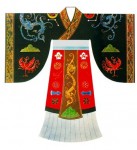Royal Ceremonial Wear
 The mianfu and the dragon robe are typical garments for ancient Chinese emperors. They serve as a micro cosmos that exemplify the unique Chinese aesthetic and sense of the universe.
The mianfu and the dragon robe are typical garments for ancient Chinese emperors. They serve as a micro cosmos that exemplify the unique Chinese aesthetic and sense of the universe.
In Chinese history there is a story of “Dressed with yellow robe” that occurred in 959 A.D. One year after a young emperor took over the throne at the death of his father, the old emperor, a general was dressed with the royal yellow robe by his supporters and made emperor. That was the beginning of the Song Dynasty. But why does the “yellow robe” represent the emperor? It all started in the Han Dynasty.
The Chinese theories of the Yin and Yang and of the Five Elements all try to explain the interdependence and mutual rejection of gold, wood, water, fire and earth. White represents gold; green represents wood; black represents water; and yellow represents earth. In Zhou Dynasty, red was regarded as the superior color for garments, but by Qin Dynasty (221 B.C.-206 B.C.) black ranked highest among all garment colors. All officials followed suit and wore black as much as they could. When Han Dynasty replaced Qin, yellow was promoted to the highest place, favored by the emperors of the time. By Tang Dynasty the court made it official that no one, except the emperor, had the  right to wear yellow. This rule was passed all the way down to the Qing Dynasty. It was said that when the 11-year old Pu Yi (1906-1967), the last emperor, saw his 8-year old cousin wearing yellow silk as his clothes lining, he grabbed the sleeve and said: “How dare you use yellow!” The status of the color yellow was apparently supreme in their heart.
right to wear yellow. This rule was passed all the way down to the Qing Dynasty. It was said that when the 11-year old Pu Yi (1906-1967), the last emperor, saw his 8-year old cousin wearing yellow silk as his clothes lining, he grabbed the sleeve and said: “How dare you use yellow!” The status of the color yellow was apparently supreme in their heart.
In ancient Chinese society, it was all strictly specified which class should wear what on what occasions. What the emperor wore on important occasions had a special name: mianfu.
Mianfu is a set of garments including the mianguan, a crown with a board that leans forward, as if the emperor is bowing to his subjects in full respect and concern. Chains of beads hang at front and back normally twelve chains each, but also in numbers of nine, seven, five or three, depending on the importance of the occasion and the difference in ranks. The jade beads are threaded with silk, ranging from nine to twelve in number. Hairpins are used to fasten the crown to the hair, and two small beads hang above the ears of the wearer, reminding him to listen with discretion. This, like the board in front of the crown, has important political significance.
The upper garment of emperors is normally black while the lower garment is normally crimson. They symbolize the order of heaven and earth and should never be confused. Dragon is the dominant pattern embroidered on the emperors clothing, although another 12 kinds of decoration can be seen as well, including symbolic animals, or natural scenes with sun and moon. These pa????erns are allowed on the lords as well, but they differ in complexity according to different ranks and importance of the occasion.
Mianfu with upper and lower garments are fastened with a belt, under which a decorative piece called bixi or knee covering hangs down. This piece of decorative cloth originated in the days when people were wearing animal skins, used primarily for covering the abdomen and the genitals. This part of clothing remained until later years, becoming an important component of the ceremonial wear. Even later, the bixi became the protector of the royal dignity. The emperor’s bixi is pure red in color.
Shoes to go with the mianfu are made of silk with double-layered wooden soles. Another kind exists that uses flax or animal skin as the sole depending on the season. By order of importance, the emperor wore red, white or black shoes on different occasions.
 The most outstanding feature of the Chinese royal attire is the
The most outstanding feature of the Chinese royal attire is the  embroidered dragon. In Ming and Qing Dynasties, the robe had to have nine dragons embroidered, on front and back of the two shoulders and two sleeves, as well as inside the front lapel, displaying the royal prominence bestowed by the gods.
embroidered dragon. In Ming and Qing Dynasties, the robe had to have nine dragons embroidered, on front and back of the two shoulders and two sleeves, as well as inside the front lapel, displaying the royal prominence bestowed by the gods.